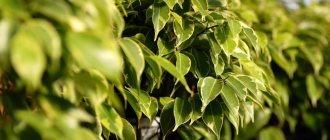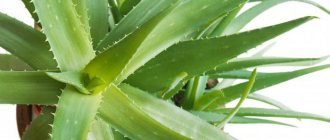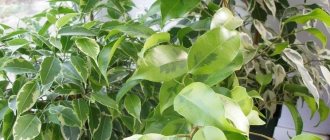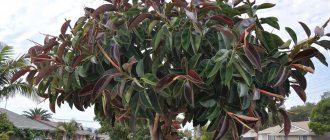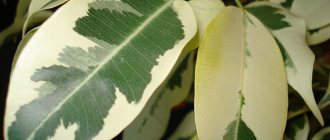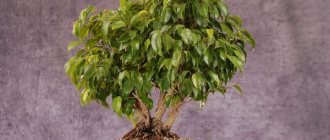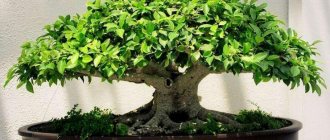Many people prefer Ficus Benjamin as an unpretentious houseplant. And no wonder, because the flower does not require special care and pleases with its rich green foliage and dense crown. In addition, ficus is an excellent company for violets and zonal pelargonium, for monstera and other indoor plants. A favorite among ficus trees is the Natasha variety. Simple care at home attracts attention to the plant, but the reasons why ficus leaves turn yellow leave gardeners with a lot of questions. Here are complete answers and photos from which you can judge the condition of the flower. Follow the recommendations - and ficus Natasha will always be healthy!
Description and appearance of ficus Benjamin Natasha
Ficus benjamina Natasha is a representative of evergreen plants from the Mulberry family. Here are the main features of this ficus:
- powerful root system that can extend beyond the soil;
- the trunk is round in shape, painted light brown;
- branched shoots, drooping;
- pointed leaves with smooth edges, smooth and slightly curved in the center.
The peculiarity of this home plant is the absence of flowering. It is impossible to achieve. This only happens in the natural environment.
Ficus benjamina Natasha grows in tropical Africa and Asia. It can be found on the coast or at the foot of the mountains. Rarely found in temperate latitudes.
All about ficus Natasha: care, reproduction, disease control
Ficus Natasha is one of the few subspecies of Benjamin that was found and gained wide popularity in the temperate climate zone. This plant is unpretentious in care; the main thing is to follow the instructions written by experienced gardeners.
Botanical description
Ficus variety Natasha looks like a small tree, due to which it looks extremely impressive in the interior. The average height of this plant is 40 centimeters, but in favorable conditions it can reach one meter.
Natasha's stem is formed from several thin but rather hard stems, which gradually begin to intertwine closer to the branching point. The ficus has many branches, they grow chaotically. The bark is colored brown-green.
The leaves are elongated oval in shape with pointed edges and a smooth border. The texture is smooth, glossy. The color can vary from light to dark green depending on the subspecies and growing conditions.
Where to place ficus Natasha
For indoor ficuses, it is extremely important to choose the right location for the future pot. Fear of drafts and sudden temperature changes makes Natasha extremely vulnerable to external irritants. If you place a plant in a cold place or leave it in the wind, it is highly likely to get sick, shed its leaves and die
Lighting and location
To grow Ficus Benjamin Natasha, you do not need to select a lighted area. This plant feels quite comfortable in the shade. The main thing is not to leave the ficus in direct sunlight, otherwise its leaves will begin to turn yellow and fall off.
Her color will depend on how much light Natasha receives. If the ficus is in a illuminated area, then the leaves will turn light green, and if in a shaded area, then they will grow dark green.
Humidity and temperature
Maintaining the correct air temperature is extremely important when growing exotic plants. Despite the fact that Natasha was discovered in a temperate climate zone, this shrub still grows better at high temperatures.
In summer, ficus feels best at 20-25 degrees. When the house maintains a cooler temperature, it is better to move the plant to the balcony or veranda, if possible. If the mercury shows 28 degrees or higher, the flower must be immediately moved to a cooler place.
In the winter season, Natasha can easily survive temperatures up to 13 degrees, but feels best at 16-18 degrees. The plant can survive such low temperatures due to the fact that it is in a state of hibernation.
The humidity in the room when growing Natasha is no less important. In order to maintain the correct microclimate, you need to spray the green foliage at least once every two days.
For this procedure, you need to use clean water at room temperature.
Frequent spraying is carried out both in summer and winter, since during the heating season the air humidity is often lower than in the hot season.
Soil for the plant
Soil for ficus can be purchased in specialized stores or prepared independently. The main thing is that the substrate is soft, loose, low-acid and consists of several components:
- Leaf soil.
- Turf.
- Coarse river sand.
- Peat or peat mixture.
Each part of the composition is added to the mixture in equal proportions. If any of the components is missing, it can be replaced with leaf soil, but only in a small percentage.
Drainage is placed at the bottom of the pot. Small pebbles are best suited for this role.
Home care
Caring for Ficus Benjamin Natasha at home does not cause problems for either beginners or experienced gardeners. Its root system is strong enough to hold the plant in the pot, the plant is watered regularly, and it is not fertilized as often as many other representatives of this species.
Watering rules
Features of caring for Natasha begin with irrigation. You cannot water it too often or according to a set schedule. The gardener must develop his own watering schedule, which will take into account all the characteristics of the growing climate.
In order to understand whether a young tree needs to be watered, you should probe the upper layers of the soil. If the first 3-4 centimeters of soil have already dried out, this means that it is time to irrigate it. Watering the ficus should be quite abundant. The excess seeps through the drainage and goes into the pan. Afterwards all the remains are drained from there. It is not recommended to maintain humidity with this liquid.
It is best to water ficuses not with running water, but with settled or drinking water at room temperature. Tap water often contains metals and trace elements harmful to plants.
Fertilizer
When caring for Ficus Benjamin Natasha at home, we must not forget about feeding. Fertilizers are mixed into water for irrigation approximately 2 times a month during the period of active growth.
In winter, the plant needs feeding only once a month.
Trimming
Natasha is a good basis for creating your own bonsai. The stems of this plant are well intertwined, and the branches are easy to trim, so the formation of the crown is quick and easy. The main thing is to ensure that the green leaves do not begin to turn yellow.
Decorative pruning includes not only trimming the branches, which is not a problem, but also working on the trunk. This is considered one of the most difficult stages of creating a Natasha bonsai. You can form a straight trunk by simply tying the plant with a gardening net, but to make a curly stem, you need to guide it for a long time with wires or ribbons.
Therapeutic pruning of ficus is carried out in the fall, while the time of active growth has not yet ended. The top branches with the smallest leaves are cut off, which will require more vitality in winter than the hibernating plant can allocate to them.
Transfer
When caring for the ficus Natasha, you need to replant it on time. In the first five years of the plant’s life, this is done annually, and after that – once every three years.
It is best to transplant in the spring, at the very beginning of March, when the ficus is just beginning to emerge from hibernation, but has not yet begun to grow rapidly. Then the “moving” will be the least stressful for him and he will not shed leaves.
Plant propagation methods
Natasha's reproduction at home occurs exclusively by cuttings. Due to the fact that the branches of this ficus are quite thin, it is best to form a baby from the main branch, and not from young ones.
After cutting, the cutting is immersed in a glass of water for the next two weeks. As soon as the first roots are formed (about 2-3 centimeters long), the baby can be transplanted into the ground. The soil should be looser during the first two stages of ficus growth. If necessary, the top layers of soil can be loosened independently.
Disease and pest control
Despite its external weakness, ficus Natasha is quite resistant to various types of pests. Its main enemy is aphids. At home, it is extremely difficult to encounter this insect, but if this happens, then the ficus simply needs to be treated with insecticides and allowed to stand in a cooler room for 2-3 days.
At the same time, improper care can lead to many difficulties when growing Natasha:
- If the air temperature is too high, it can cause the leaves to turn yellow. Changing the climate to a cooler one will completely solve this problem.
- An abundance of moisture can lead to rotting of the roots and death of the plant.
- Lack of fluid will result in the fall of leaves to save the vital energy of the bush
Ficus Natasha is an unusual solution for bonsai lovers and simply for fans of exotic plants. It takes root well in a temperate climate, it is easy to care for, the main thing is to follow the instructions and maintain the correct microclimate in the room where the indoor tree will be located.
Source: https://podokonnik.temadnya.com/1528297995077683325/vse-o-fikuse-natasha-uhod-razmnozhenie-borba-s-zabolevaniyami/
How is it different from other varieties?
Today there are 22 varieties of Ficus Benjamin. The Natasha variety is considered quite popular among lovers of home exotic vegetation. The leaf length usually does not exceed 3 cm. The older the leaves, the darker they are.
A distinctive feature of this tree is its relative unpretentiousness. The plant needs to be planted, watered and fed in a timely manner. However, it is required to protect it from direct sunlight. Therefore, on hot days, the tree should be sprayed with water from a spray bottle. It is also important to ventilate the crown daily using light shaking.
Advantages of this variety:
- unpretentiousness compared to other species;
- the ability to easily form a crown;
- a large number of leaves;
- reasonable price for ficus in specialized stores.
This type of ficus allows you to show your imagination when pruning the crown. What shape it will have depends only on the owner of this tree.
Is replanting required after purchase?
It is unknown how long the plant was in the store. In any case, small pots are used there. Therefore, it is recommended to replant it after purchase.
A healthy plant should change its container every 2-3 years. After purchase, you need to give the plant 7-12 days to acclimatize. When transplanting, it is removed from the pot along with the soil.
You need to lay expanded clay on the bottom of the new container in a slide, which will serve as drainage, and pour the prepared soil on top. Next, the tree itself is placed in the pot, the root of which is covered with soil. It should be noted that you should not take the pot “for growth”. Its diameter should be 3-5 cm larger than the previous one.
Temporary soil can have a detrimental effect on the plant, and it begins to wither. This happens because the nutrients run out and are not suitable for normal growth over time.
When buying a healthy ficus, you need to pay attention to the following:
- no signs or fresh cuts on the trunk;
- all branches with foliage;
- the greens are bright, without signs of drying or spots;
- has no pests.
If there is a suspicion that the plant is sick, you should not buy it.
Home care
Ficuses require special attention. Therefore, it is worth considering the basic nuances of caring for this plant.
Watering
It is necessary to water the soil in a timely manner. In this case, you need to calculate the optimal time for watering. The following is required:
- air humidity;
- room temperature;
- plant size;
- season.
It is recommended to moisten the soil when it dries to a depth of 1 cm. Water should be used that is warm and settled. The chlorine contained in the water has a negative effect on the flower, burning the foliage. Watering should be thorough, removing excess liquid after 30 minutes.
You can give your ficus a shower by spraying it with a spray bottle. This will be a good addition. However, overwatering should be avoided.
Fertilizer
Outside of nature, ficus trees grow rather slowly. But fertilizing can speed up this process. For this, any water-soluble mixtures for palm trees are used. These include “Gumisol”, “Rainbow” and many others.
It is required to apply fertilizer in accordance with the instructions. Excessive introduction into the root system can destroy the plant. The following minerals need to be in sufficient quantities:
Lighting
This plant needs a lot of light. Therefore, the pot should be on the south side. It is important that the windows are well lit, otherwise a crooked trunk may form.
Temperature and humidity
Humidity and air levels are moderate. The plant tolerates short-term drought well, but if overwatered, it quickly dies. A grower has the opportunity to succeed in growing a healthy ficus if he maintains a humid climate in the room where the plant is located by installing a humidifier or misting his pet twice a day.
It is advisable to maintain the temperature at the same level all year round. Optimal level: + 23-25 degrees. Winter minimum temperature: +10 degrees, if lower, the plant dies. It is worth noting that plants can suffer from fairly low temperatures.
Trimming
Ficus requires regular pruning. This will allow you to form the crown and skeletal branches, as well as remove small diseased areas of the bush. Which branches need to be trimmed:
- lower ones, appearing on the trunk;
- without side shoots.
- the upper ones, on which there are no leaves or few of them;
- dry;
- broken pieces of wood.
Ficus Natasha or what is the secret of special attractiveness
Many people prefer Ficus Benjamin as an unpretentious houseplant. And no wonder, because the flower does not require special care and pleases with its rich green foliage and dense crown. In addition, ficus is an excellent company for violets and zonal pelargonium, for monstera and other indoor plants.
A favorite among ficus trees is the Natasha variety. Simple care at home attracts attention to the plant, but the reasons why ficus leaves turn yellow leave gardeners with a lot of questions. Here are complete answers and photos from which you can judge the condition of the flower.
Follow the recommendations - and ficus Natasha will always be healthy!
Ficus Natasha: description and features
Dwarf Natasha, whose height reaches 40-60 cm, is an excellent option for those who do not like huge indoor plants in tubs. Its advantage is the ability to create bonsai. Consequently, ficus will look great in a room of strict modern styles, classical and national. In any of them, an indoor flower will become a real decoration!
The homeland of ficus is the islands of Borneo, Java, and Ceylon. Here there are specimens reaching 10 meters in height, the trunk diameter of which is 1-1.2 m. But the “domesticated” version is adored by flower growers for the rich color of the foliage, ease of care and positive energy.
Ficus Natasha does not like changing places
Ficus Benjamin Natasha is different from others:
- bush height;
- the ability to twist the flexible trunks of several plants into one when creating a bonsai;
- small leaves, the size of which is 1.5x3 cm;
- shade of leaves. It can be not only uniformly green, but also have inclusions in the form of white dots and yellowish veins;
- easy formation, which allows you to get either a spreading mini-bush or a compact tree.
Ease of care and attractive appearance are factors that ensure Natasha’s enormous popularity. All that remains is to create optimal conditions for growth - and the whole family will fall in love with the flower.
Attention! When creating a bonsai, you can twist and tie young stems in a knot. However, it is worth remembering that those that have reached a height of 10-15 cm are most suitable for this.
Caring for Natasha at home: TOP 5 important rules
Despite the fact that ficus Natasha cannot be called whimsical in care, it requires attention like any indoor flower. By learning the basics of care, you can avoid many problems, grow a healthy flower and enjoy its long life on your windowsill.
The rules for caring for ficus are as follows:
- Lighting. The flower does not tolerate direct sunlight in summer; it can cause burns to the foliage. The best option is diffused light for as long as possible, and the absence of heating devices nearby (in winter) to avoid dry air.
- Temperature. In the summer months, Natasha feels great at a temperature of +20-25 °C; in the winter, the temperature should be lowered, as the plant enters a dormant period. At this time, for variegated forms the temperature should not fall below +15 °C, for monochrome forms - below +10 °C.
It is very important not to over-water or over-dry the soil.
- Watering (nutrition). Ficus Natasha does not like dry or waterlogged soil. Therefore, watering it is a step-by-step process to ensure even distribution of the substrate. Attention: water should only be used at room temperature; any remaining water should be drained 30 minutes after the end of the water procedures. Natasha loves feeding, but it should only be done during the period of active growth, in the summer months. You can feed the flower with special preparations and do this once every 14 days.
- Transfer. The first time to replant a flower is 1-1.5 months after purchase. In this case, the next pot should be no more than 2 cm in diameter larger than the previous one. Adult specimens can be replanted once every 2-3 years or simply add a layer of soil.
- Formation. Ficus Natasha can be easily given any shape. You need to start forming a plant from the moment the plant actively begins to grow. A pruning shear or special garden shears and jute will help with this.
Attention! When following the growing rules, do not forget that the ficus cannot be moved from place to place. Even if you start pruning, later place the flower as it was.
These are the basic rules that will allow you to get a healthy and beautiful plant in the house, pleasing to the eye. And who knows, you might decide to create a whole greenhouse out of dwarf ficuses?!
Yellowing of ficus leaves: problems and solutions
Yellow leaves often have several causes. By elimination, you need to determine the one by which the leaves turn yellow in your case. Photos and measures to eliminate yellowness will help you with this. It is worth remembering that failure to provide assistance to the plant at such a moment is fraught with complete loss of leaves.
Yellow leaves of ficus Natasha. Why?
A healthy plant has strong leaves that adhere tightly to the petioles. If the leaves begin to turn yellow (fully or partially) or fall off, it is worth determining the reason for this. It could be:
- low air temperature if it is the winter months, as well as dryness if it is summer;
- improper feeding, that is, excess or lack of nutrients, micro-, macro-elements;
- excess or lack of moisture.
If not properly cared for, ficus leaves turn yellow.
It is also worth paying attention to pests (spider mites, scale insects) and fungal diseases that can cause leaf damage. However, their external manifestation is different, so it is necessary to combat yellowing and drying out of the foliage.
Fighting yellowing of leaves, or proper care
So, the reasons for the yellowing of ficus leaves have been identified. The following activities will help the flower become healthy:
- maintaining optimal temperature in a certain season;
- use of special fertilizers. The flower shop seller will help and advise, select the preparation for feeding that will contain the required amount of nitrogen, potassium and magnesium, and other important components;
- competent watering in several stages.
Following simple rules will help make ficus Natasha a favorite in the house. They can easily decorate your husband’s office, a bathroom with a window, or a children’s room. And a wonderful living friend will always be there!
Ficus propagation: video
Source: https://sad24.ru/cvety/komnatnye/fikus-natasha-sekret-osoboj-privlekatelnosti.html
Difficulties in growing the Benjamin Natalie flower
The most difficult thing is to choose a suitable place for such a capricious plant. Here are some recommendations on which place to choose:
- air humidity about 50%;
- temperature - 23-25 degrees;
- distance from the battery is at least 1 meter;
- far from open windows and doors;
- the entire crown should be illuminated evenly;
- You should not constantly move the pot, as the ficus prefers to be in one place.
Quite a lot of difficulties arise due to the fact that it often has to be sprayed and periodically placed under the shower. If not properly cared for, it stops growing. There is also a risk of developing various diseases. They develop quickly, completely destroying the plant.
What to do if the leaves turn yellow and fall off?
From time to time you may encounter this problem. Leaves may turn yellow:
- Incorrect watering. Due to the large amount of moisture in the soil. You can try not watering the ficus for a while. Also, do not turn the pot. If after 5-7 days there is an improvement, then this is the reason. If there is no improvement, then the plant needs to be replanted. Some roots will be rotten. They are removed with a knife.
- Cold. A slight draft, a sudden change in temperature or cold water for irrigation is the cause of yellow leaves that will fall off. So that he does not face the cold.
- Replanting is stressful, so be prepared to lose a few leaves. It is normal that the ficus will need some time to adapt.
- Lack of microelements. Magnesium, iron and nitrogen are required in sufficient quantities for normal growth and development. Fertilize according to instructions in spring and summer. Excessive amounts of minerals are another cause of yellowing and leaf drop.
- Pests. They are easy to detect upon superficial inspection. It is necessary to get rid of them with fungicides or other poisons.
- Diseases. They are accompanied not only by yellowing of the leaves.
These are the main reasons for yellow leaves falling off.
Darkening of the stem
Most often, the trunk darkens due to the following reasons:
- sudden change in microclimate;
- the appearance of root rot;
- mealybugs and spider mites that feed on plant sap (requires the use of fungicides).
If any of this list is present, then the problems are really serious and emergency measures are required to save the plant.
Twisting a sheet plate
In Ficus Benjamin Natasha, leaf curling is not the norm, unlike the Baroque variety. The reason for this phenomenon may be the following factors:
- being near a battery in winter;
- high air temperature;
- moisture deficiency or waterlogging of the soil;
- sunburn;
- use of cold water for irrigation;
- damage by pests or infections.
There are two reasons: improper care or exposure to pests. If the latter are not detected, then it is necessary to identify the potential cause of the twisting and eliminate it.
Why do ficus leaves turn yellow and fall off?
“Experienced” people know that sometimes Benjamin’s ficus sheds its leaves. This is typical for this variety. With similar types of ficus this happens less often, although it also happens. One of the reasons is that the presented flower, or rather some of its subspecies, are quite “capricious” plants that require special care.
Ficus has dropped its leaves - in what cases is this normal?
And although some consider it abnormal for a ficus to shed its leaves from time to time, there is nothing unusual about it. During the winter and autumn months, some leaf blades fall off. Usually we are talking about the lower leaves. In this case, you should not sound the alarm and do something. In the spring, the plant will produce new green plates, and in even greater quantities.
The same applies to leaf fall after rearranging the flower. The plant does not like such manipulations, so it reacts to it very sharply. By returning the ficus to its original place, or by saving the flower from moving in the future, you can forget about the fact that the ficus sheds its leaves.
Leaf blades turn yellow and fall off - which led to the problem
Unfortunately, there is more than one reason that can lead to ficus benjamina’s leaves turning yellow and falling off.
The most common of them are:
- improper watering;
- non-compliance with temperature conditions;
- dryness in the room;
- illiterate transplantation;
- substrate depletion;
- pest attack.
Improper watering
Of course, when the leaves of the Benjamin ficus begin to fall, it seems that something outside is to blame, but not the gardener himself, who did something wrong. However, mistakes in care are normal, especially for novice gardeners. True, the main thing is to correct the situation in time, identify the causes and begin to eliminate them.
Usually the problem is watering. Gardeners either overwater the flower, or, on the contrary, are afraid to overdo it with liquid. In the first case, root rot begins, which weakens the plant. In the second, the plant is trying to preserve life in the roots and stems (due to lack of watering), so fallen leaves are the result of work to preserve moisture.
To determine exactly what the problem is, just look at the soil. If it is dry, it is necessary to establish a watering and spraying regime. In summer, manipulation is performed more often, and in winter - less often.
If the substrate is wet, you need to remove the flower from the pot and carefully examine the root system. Rotten roots are removed, and the plant is transplanted into a new soil mixture and a new container.
Important! Sometimes ficus leaves turn yellow and fall off as a result of a lack of iron in the soil.
In order to correct the situation, it is enough to add special fertilizers to the soil, which are sold in flower shops. Iron chelate, Ferrovit or something similar will do. It must be remembered that fertilizers are applied only to a moist substrate.
Temperature
Sometimes it is quite simple to determine why ficus leaves turn yellow and fall off. You just need to look at the thermometer in your home. If the mark is above +25 °C, there is nothing surprising in leaf fall. In a hot and stuffy room, leaf blades lose turgor, turn yellow and crumble. The optimal temperature should be within +18..+24 °C.
High rates, like low ones, negatively affect the appearance of the flower. Hypothermia primarily affects the root system, in which irreversible processes occur that “scream” about a sad state of affairs with problems with leaf plates.
Important! If the apartment is cold and the flower is in a pot on the floor, it must be placed on some kind of elevation, at least on a small chair.
In addition, in winter the plant must be removed from windows from which it blows or kept away from cold walls. In addition to yellowing, the leaf blades may even curl.
Dry indoors
Ficus does not tolerate dry air. Stuffiness results in yellowing of the leaf blades, as well as their falling off. In order to solve the problem, it is enough to spray as often as possible and arrange a “shower” for the plant from time to time. True, experienced gardeners still recommend getting an air humidifier, since it is not always easy to determine whether the ficus needs to be sprayed or not.
Incorrect plant replanting
There are people who believe that replanting is the best way to prevent root rot and also prevent pests from settling on the flower. It is not at all surprising that after several manipulations they do not understand why the ficus leaves are falling off if everything was so good. What is good for the gardener does not mean “good” for the plant itself. There are rules and they must be followed. Transplantation is performed once every two years. This is that substrate.
In this case, the manipulation is performed as follows:
- The ficus is removed from the pot and shaken off excess soil mixture.
- Drainage is poured into a pre-prepared flowerpot, and the whole thing is covered with soil on top.
- After this, the flower is planted in a new container (it is desirable that it be 3-4 cm larger than the previous one).
- The remaining space in the flowerpot is filled with soil mixture and fertilizers.
- At the end of the manipulations, the flower is watered.
This is the only way a transplant is performed and no other way. If something is done differently, you should not ask yourself why the leaves are falling, because in this case it will be completely natural.
Substrate depletion
Another reason why the ficus turns yellow and drops its leaves is soil depletion. Knowing that the flower is not a fan of frequent transplants, many try not to touch it again. And after a couple of years it turns out that there are no useful substances left in the soil mixture.
Of course, there is no need to constantly replant the plant, but there is a need for regular feeding. Liquid fertilizers for decorative foliage flowers are best suited. In addition, it would also be a good idea to remove the top layer of soil from time to time and add a new substrate in its place.
Pest attack
Ficus often disappears because all kinds of parasites appear on it.
These include:
- scale insect;
- spider mite;
- thrips.
Some believe that this does not cause flowers to dry out, not knowing that it may be even more serious. The fact is that such parasites suck the juice out of the ficus, weakening the plant. In order to prevent the appearance of pests, it is necessary to wipe the sheets daily with a damp cloth. If it is not always possible to do this, and the pest has already made itself known, then you should fight it.
As for the scale insect, the female of this parasite constantly sits on the flower, covering the laid eggs, regularly secreting a sticky liquid that provokes the active development of the fungus. Gardeners recommend removing the pest using insecticides. If they did not have the desired effect, and this sometimes happens, since the scale insect has a very dense shell, then you should make a garlic solution and sprinkle the ficus well with it. The procedure is carried out several times a week, for a month. At the same time, it is necessary to change the top layer of soil in which the larvae could survive.
Important! After successful treatment of the flower, a preventive treatment should be carried out a month later.
Spider mites are no less dangerous pests. Therefore, when thinking about why the leaves on the ficus turned yellow, we can assume that the reason is precisely the parasite presented. The tick feels great in warm and hot rooms, actively reproducing at the same time. It is not difficult to notice the appearance of the parasite, because yellow dots first appear on the leaf blades, and then you can notice a white coating. Already at this stage the flower dies. Therefore, if you do nothing, after a while the plant can simply be thrown away. At the same time, every gardener should know how to save a ficus, especially since it is not so difficult to do. It is enough to alternately treat the flower with either a sulfur agent or a phosphorus agent.
Thrips are another uninvited “guest” that can settle on a flower. The presented parasites lead not only to the fact that the leaves of the ficus tree fall off, but also to the fact that the stem begins to disappear. The danger of pests lies in their rapid reproduction at temperatures of +20..+25 °C, as well as the ability to transplant from one flower to another, parasitizing all the plants around them. In this case, there is no longer any point in asking yourself why the ficus leaves are drying or how they allowed such a temperature in the room. The most important thing in this case is to get rid of thrips. This can be done with the help of insecticidal preparations. Treatment should be carried out over several weeks.
Important! Preventing pests is much easier than dealing with them afterward.
Do not forget about regular spraying of the flower and optimal air humidity.
Preventive measures
Following a number of rules will make it possible to avoid many problems.
The rules are as follows:
- If in winter the air temperature in the room is below +14 °C, the flower is not irrigated. In addition, watering is kept to a minimum.
- From time to time you need to wipe the leaf plates with a damp sponge.
- Ficus leaves will not dry out if the flower is kept away from the scorching rays of the sun and heating appliances.
- The plant is replanted in the spring.
- Before watering, the soil must be loosened.
Why do the leaves keep falling?
Sometimes a ficus dries out because the root system of the flower rots, and there may be no apparent reason. In terms of the fact that the substrate is not soaked or dry. It is quite possible that the problem appeared much earlier, but the gardener did not give it due importance or thought that the ficus shed its leaves seasonally.
In this case, you should remove the plant from the pot and evaluate the condition of the roots. If there are strong roots left, then all the rotten parts are cut off, and the remaining ones are briefly soaked in a manganese solution, after which the plant is planted in a new container and new soil.
As you can see, what to do if the leaves of the Benjamin ficus turn yellow and fall off depends on the reason that led to such consequences.
moiorhidei.ru
Superstitions and signs associated with the plant
There are several signs associated with the ficus being in the house.
- This plant is believed to cause gossip and scandals in the home. They also call him muzhegon.
- In other countries it is a symbol of family and harmony in the home.
In Thailand, he helps solve many complex problems. And in some Asian countries it is believed that ficus will help to conceive a child.
Thus, if you do not follow the basic rules of care, you can provoke yellowing and falling of the plant’s leaves. Ficus does not require special care. The main thing is that it is sufficiently humid and warm. By studying the features of ficus care, you can grow a large and healthy tree.
—Search by diary
—Subscription by e-mail
-Statistics
Saturday, June 10, 2022 19:00 + to quote book
Ficus Benjamin Natasha ( Ficus Natasja ) is a variety that has gained wide popularity. It has long been believed that this plant gives love and family well-being - the more intensively it grows, the happier the relationship will be. But what features does this miniature tree have, how to properly care for it, and what you need to know about the most common diseases and treatment. The homeland of ficus trees is considered to be hot countries where summer reigns all year round. That is why the flower needs to be kept at a certain temperature - the room must be warm and humid.
Ficus benjamina, variety - Natasha
Ficus Natasha in appearance looks more like a small shrub than an indoor flower. The leaves are slightly elongated and uniformly green. At home, the plant does not bloom. A fairly common question is how to braid branches. You just need to plant the stems side by side, connecting them together - and you’ll get
stylish and unusual decorative element.
What should the microclimate be like?
Ficus feels great at temperatures from +20 °C to +25 °C. True, given that in winter all flowers (ficus is no exception) have a rest period, these indicators may be slightly lower.
Important! At temperatures below +10 °C, the ficus begins to die.
When caring for your ficus Natasha, you should also remember about the air humidity in the room where the flower stands. The ideal would be 50-60%. If the room is stuffy, then you need to regularly spray the flower. It is also recommended to place a container of water next to the pot.
Ficus "Benjamina Natasha": general description and photo
Ficus leaves
Ficus Benjamin Natasha is a small-leaved dwarf tree with oval wavy leaves of the Mulberry family.
Ficus "Benjamina Natasha" has leaves from 6 to 9 centimeters.
Shaping the trunk
Ficuses of this species lend themselves well to pruning and can be given any interesting shape. Often a tree is made on a trunk.
Ficus trunks are quite flexible, and often several plants are planted in one pot and intertwined with each other.
It grows quite quickly at home and turns into a beautiful dwarf tree with proper care.
Ficus "Benjamina Natasha (Natalie)" photo:
Botanical description
Ficus variety Natasha looks like a small tree, due to which it looks extremely impressive in the interior. The average height of this plant is 40 centimeters, but in favorable conditions it can reach one meter.
Natasha's stem is formed from several thin but rather hard stems, which gradually begin to intertwine closer to the branching point. The ficus has many branches, they grow chaotically. The bark is colored brown-green.
The leaves are elongated oval in shape with pointed edges and a smooth border. The texture is smooth, glossy. The color can vary from light to dark green depending on the subspecies and growing conditions.
Home care
Features of care after purchase
Caring for the ficus "Benjamina Natasha" is not very easy. With proper watering, lighting and humidity, the plant grows into a beautiful small tree and pleases the owner with greenery all year round.
Then the young plants are replanted once a year, most often in the spring during the active growth of shoots, then as the pot becomes too small for roots.
When a ficus grows more than one and a half meters, it is advised not to change the pot , but simply add more soil, because such a large plant is not very convenient for replanting, and the root system of ficuses is quite sensitive and requires very careful handling.
Lighting
Ficus benjamina is very light-loving; light makes the leaves of the plant glossy.
Ficus loves bright light and tolerates direct sunlight.
Windows facing southeast or southwest are perfect for this type of plant.
Try to rotate the plant as often as possible so that it receives light evenly from each side.
Standing in partial shade, it will develop worse, and the trunk may become bent, as the ficus will begin to “reach towards the sun.”
Temperature
Ficus Benjamin Natasha, like any other tropical plant, is very thermophilic.
The optimal temperature for it will be 25-30 degrees.
With constant spraying it will be easier to tolerate hot weather.
If you have a loggia or balcony, then this place will be an excellent solution for a plant for the summer
Air humidity
Ficus grows well in rooms with high humidity.
It will appreciate frequent mistings, especially during the dry summer months.
You can also periodically give your pet a “warm shower”.
Watering
Ficus "Natalie" prefers regular moderate watering; it is best to use warm, settled water.
In summer, as the top layer of soil dries out, in winter, less often, but without allowing the roots to dry out completely.
Crown formation
If you want to give a beautiful shape to the crown of your ficus, then it is best to start doing this with a young tree, since the shoots of the ficus quickly take on a horizontal position and the tree turns out to be one-sided.
Often several bushes are planted in one pot, their trunks intertwine with each other, then these places can grow together.
The result is a denser and more branched plant.
Fertilizers and feed
It is best to feed the plant during the period of their greatest growth, that is, in summer and spring.
Liquid fertilizers for ficus and palm trees are perfect for this purpose.
Transplantation and soil
The plant is replanted very carefully; ficus benjamina has very sensitive roots.
It tolerates replanting best in the spring during active growth.
It is recommended to use fertile and breathable soil.
You can also add sand and humus to the soil.
Methods of flower transplantation and fertilizer
Some flower growers who do not know how to care for the ficus Natasha replant the plant both in winter and summer, which should not be done. The presented species tolerates such manipulations very poorly.
Young plants are replanted only in the spring and only once a year. When the ficus has reached the age of three, the procedure should be performed once every 3-4 years. Older bushes are replanted only if absolutely necessary. Experienced gardeners recommend simply changing the top layer of soil in the pot.
All the beauty of the flower lies in its lush crown and the brightness of the leaf plates. However, in order to achieve this, you should regularly fertilize. Manipulation is carried out from spring to autumn. Nitrogen fertilizers are best suited, although you can buy something else, but you need to make sure that the fertilizing is for ficus.
Reproduction
Propagation is mainly done by cuttings; roots form well in water. Recommended temperature is 25-30 degrees.
You can also plant the cuttings in specially prepared soil with moss and cover with film. Most often, cuttings with roots are planted in the ground.
It is advised to wash off the juice released from the cut site, otherwise the vessels will become clogged and the roots may not appear.
Growing ficus trees from seeds at home is quite difficult.
Flowering and fruits
Flowering in this type of ficus is rare, and most often it occurs in natural habitats.
Benefit
Ficus has long been called the “Family Flower”. It is believed that the family in which this plant appeared will have children in the near future.
This type of ficus has a wonderful property - it is able to purify the air from benzene and phenol, converting them into amino acids.
It makes an invaluable contribution to the indoor microclimate.
Scientific name
Ficus Benjamina Natasha received its name in honor of the outstanding British botanist Benjamin Daydon Jackson, compiler of the famous reference book on floriculture. This tree is also a symbol of Bangkok.
Diseases and pests
Why are the leaves of the ficus "Benjamina Natasha" falling off? What to do?
The plant is quite whimsical in caring for.
With a lack of light in the cold season, when the plant cools (drafts), the ficus "Benjamina Natasha" sheds its leaves.
And under no circumstances should you flood the flower - it will also shed all its leaves.
The main pests that attack the leaves and trunk of the plant are mealybugs, aphids, scale insects and spider mites. A cotton pad soaked in soapy water or alcohol solution will help get rid of pests.
Special preparations such as Karbofos, Inta-vir, Actellik are also successfully used.
With proper care, timely watering and a comfortable temperature, the ficus grows well, quickly acquires new leaves and turns into a beautiful small tree.


